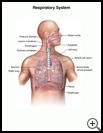
Collapsed Lung (Pneumothorax)
What is a collapsed lung?
A collapsed lung, also called a pneumothorax, happens when air enters the space between your rib cage and one of your lungs. The air makes it hard for the lung to expand and causes all or part of the lung to collapse. It is then hard to breathe normally and your body gets less oxygen. A collapsed lung can be life-threatening. In some cases, the air collecting around the lung can completely collapse the lung and put pressure on the heart. Then the heart cannot pump normally.
A collapsed lung may be caused by an injury to the chest, such as a car accident, stab or bullet wound, or broken ribs. It may also be caused by lung damage from chronic lung diseases, electric shock, or near drowning.
Sometimes there is no known cause for the lung to collapse. This is called a spontaneous pneumothorax. It may be caused by having a history of smoking and chronic obstructive pulmonary disease (COPD).
What can I expect in the hospital?
Several things may be done while you are in the hospital to monitor, test, and treat your condition. They include:
Monitoring
- You will be checked often by the hospital staff.
- Your heart rate, blood pressure, and temperature will be checked regularly.
- Your blood oxygen level will be monitored by a sensor that is attached to your finger or earlobe.
- A heart (cardiac) monitor may be used to check your heartbeat.
Testing
Testing may include:
- Arterial blood gas (ABG): A blood test to measure the levels of oxygen and carbon dioxide in your blood
- Blood tests to check for infections
- X-rays: Pictures of the inside of the chest to check for air or fluid around the lungs
- Computed tomography (CT) scan, which is a series of X-rays taken from different angles and arranged by a computer to show thin cross sections of the chest and lungs
Treatment
The treatment for pneumothorax depends on its cause, your symptoms, how well you respond to treatment, your overall health, and any complications you may have.
- You will have a small tube (IV catheter) inserted into a vein in your hand or arm. This will allow medicine to be given directly into your blood and to give you fluids, if needed.
- You will receive oxygen through a small tube placed under your nose or through a mask placed over your face.
- You may need a procedure or surgery to treat the collapsed lung. Surgery may include:
- Needle thoracostomy: Use of a needle and syringe to remove a small area of air
- Tube thoracostomy: Surgery to insert a tube between the ribs into the air pocket to remove it. The tube may be connected to a device to help suction out the air. Your provider may use chemicals to cause the leak to close (called pleurodesis)
- Video-assisted thorascopic surgery (VATS): A procedure in which a slim, flexible, lighted tube is placed through a small cut in the chest to see the space around the lungs. Often another small cut will be made in the chest that the surgeon will use to treat the collapsed lung. This may involve stapling the area closed or using chemicals to cause the leak to close.
- Thoracotomy: Surgery to close the area of the lung that is leaking. This may include sewing the area closed or using chemicals to cause the area to close.
- Your provider may prescribe medicine to:
- Treat pain
- Treat or prevent an infection
- Reduce swelling in the airways
- Help relax your airways
- Your provider may recommend other types of therapy to help relieve pain, other symptoms, or side effects of treatment.
What can I do to help?
- You will need to tell your healthcare team if you have new or worsening:
- Trouble breathing
- Coughing up mucus that is thick or blood-stained
- Chest pain
- Fast heartbeat
- Chills or muscle aches
- Anxiety
- Confusion
- Ask questions about any medicine, treatment, or information that you do not understand.
How long will I be in the hospital?
How long you stay in the hospital depends on many things, such as your general health, why you are in the hospital, and the treatment you need. The average amount of time to stay in the hospital with a pneumothorax is 5 to 7 days. Talk with your provider about how long your stay may be.
Last modified: 2016-01-20
Last reviewed: 2016-01-19

